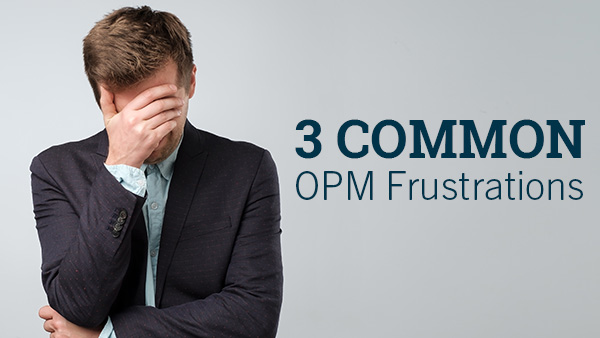In early October, Charlie Rose, Former General Counsel for the Department of Education and Stakeholder at Hogan Marren Babbo & Rose LTD, spoke at our Collegis Education Summit about the rapidly changing regulatory environment in higher education. Rose told those in attendance that the Department of Education’s focus on student welfare is not only driving financial aid reforms and the administration’s response to the Supreme Court’s ruling on affirmative action, but also its attitude toward “third-party servicers and OPMs.”
With all signs pointing to looming changes, institutions may be confronting the inherent risks and limitations of the revenue-sharing model. We interviewed several higher ed leaders to understand the common pain points they experienced working with OPMs and the benefits they realized after ending the relationships. Here’s what they told us:
3 Common OPM Frustrations
No Internal Capacity
OPMs operate in a black box. They have little incentive to share their knowledge, strategies, or insights. That means schools are outsourcing skills and infrastructure instead of developing them in-house and building capacity with their own resources. When the relationship ends, the school is left without the capabilities or expertise to grow their enrollments.
No Funds for Investment
OPMs typically insist on signing long-term contracts and handing over as much as 50% of enrollment revenue (or more). Over time, revenue-share agreements strip away the revenue needed to fund strategic investments and growth opportunities.
No Access to Data
OPMs are often reluctant to share data and aren’t obligated to, leaving schools without an understanding of why some decisions are made, how their students behave, or what tactics prove effective. Lack of data transparency prevents schools from learning how to operate at scale. OPMs own the data — and, generally, they retain possession if the relationship ends.
3 Benefits of Exiting an OPM
Growing Internal Capacity
When enrollment growth is supported by a collaborative partner, your school can learn and build its expertise in recruiting, marketing, and retention. The right strategic partner will help you realize the value of your technology by providing a clear picture of your current tech ecosystem, connecting siloed systems to gain efficiency, and delivering greater insight into the student experience. Transparency helps empower your team to learn, strategize, and exercise greater autonomy in their positions — making key decisions themselves with the guidance of an experienced partner.
Investing in Programming
When you enter a fixed-fee partnership, all revenue earned belongs to your school. You can realize the benefits of scaling and invest that revenue into improving technology for programs or fund other key initiatives that improve enrollment and retention.
Owning the Data
A collaborative partnership with data enablement experts can help your institution collect, connect, and activate data across the student journey to improve the student experience, optimize business processes, and inform strategic decisions. Your school should have complete insight into the data and be able to access it at any time. The data belongs to you, and, as the only Higher Ed Google Cloud Partner for Data Enablement, Collegis has a proven framework to help you leverage it now and in the future.
Take Control of Your OPM Story
Is an OPM relationship still the right fit for you? OPMs leave schools without full control over the future of their online programs, but that doesn’t have to be where your school’s story ends. Exiting from an OPM relationship and working instead with a strategic partner can help your school increase autonomy and revenue.
Download A Guide to Exiting from Your OPM to start the journey toward becoming a more independent success story.






